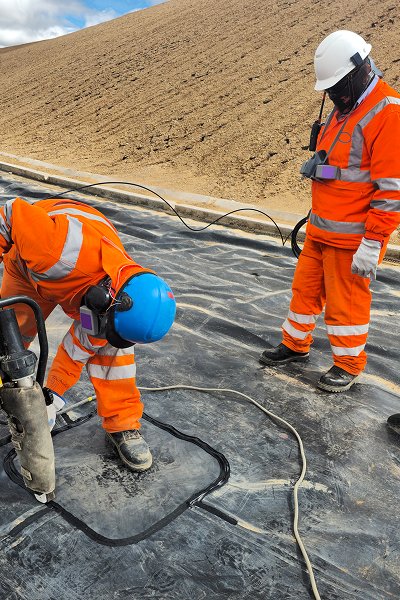Honeycomb structure design is the result of the intersection of bionic structures and engineering mechanics. Whether it's honeycombs, skeletal pores, basalt columnar joints, or densely packed dome structures, they all achieve extremely high stability and efficiency with relatively low material consumption, providing a natural model for geocell structural design. After applying this structural concept to foundation and roadbed engineering, engineers have discovered that even in weak strata or mobile sand bodies, honeycomb structures can significantly improve shear stiffness, reduce settlement and deformation, and far surpass traditional rigid solutions in terms of cost-effectiveness and construction efficiency.
Mechanical mechanism of geocell honeycomb structure
Planar "Load Diffusion": From Point Load to Surface Load
On unreinforced loose foundations, vehicle loads and structural loads directly impact the soil at a "point or small area" level, causing deep shear deformation, rutting, or uneven settlement. However, with honeycomb cells installed above:
The load first acts on the particles filling the cells.
The particles are constrained by the cell walls, resulting in a lateral "diffusion of forces."
The localized high stress point is converted to a large, low stress surface.
Anti-lateral confinement: Prevents lateral escape of particles.
The most typical failure mode of loose fill under load is not crushing but lateral flow. Once lateral movement occurs, the superstructure inevitably sinks. The geocell walls provide circumferential confinement:
Limiting lateral movement of particles within the cavity
Increasing the fill's internal friction angle (φ↑)
Reducing shear deformation and the rate of sinking.
"Arch Effect" Mechanics: Structured Loading Rather Than Discrete Loading
Under repeated loading, filler forms micro-stress arches within the cell cavity, similar to the load-bearing mechanism of an arch bridge. Arch structures have two major engineering properties:
Transferring vertical stress along a curved path to the cell walls and surrounding soil
Preventing stress from concentrating downward through the soft foundation.
Improved shear stiffness of the cell-filler composite
The cell body and particles form a monolithic composite structure through friction and interlocking, resulting in:
Higher shear stiffness
Lower vertical compression ratio
Improved deformation coordination
Why is the honeycomb more effective than other shapes?
Honeycomb structures offer the highest "area filling efficiency."
Among repeatable flat shapes (circles, triangles, rectangles, and hexagons), only hexagons offer:
Completely seamless splicing (no gaps or weak spots)
Minimizes cell divisions (reducing weld points and stress concentrations)
Maximizes coverage area for the same material consumption

The honeycomb structure is an ideal engineering unit that is both strong inside and flexible outside.
The honeycomb cavity walls are continuously closed, creating circumferential, rather than linear, constraints.
It can generate uniform confining pressure on the filler.
It can accommodate slight foundation deformation without damaging the overall structure.
It can maintain overall stiffness under conditions such as scour and fatigue loads.
The advantages of honeycombs have been demonstrated in nature and engineering.
Honeycomb structures are widely used in nature for applications requiring high strength and lightweighting, such as:
Bee hives
Porosity in bird bones and lightweight skeletons
Columnar joints in cooled basalt
Metal honeycomb sandwich structures for aviation panels
Engineering applicability and typical applications
Improving the bearing capacity of weak foundations
In soft soils such as silt, silty clay, and saturated sand, settlement and sliding are common even with crushed stone or concrete reinforcement. Cells provide three-dimensional restraint:
Limiting subgrade displacement and shear failure
Distributing loads over a wider area
Reducing replacement fill thickness and construction effort
Road Structural Layer Stabilization and Rutting Prevention
Expressways, national and provincial highways, and urban roads are subject to repeated vehicle loads over time, often resulting in rutting, cracking, and mud oozing. Cells, used in the base or subbase layers, can form an "anti-rutting structural layer":
Improve structural fatigue resistance
Control shear deformation at the bottom of the asphalt layer
Extend road life and reduce maintenance frequency
Slope protection, embankment, and river channel scour prevention
Exposed slopes and embankments often become unstable due to rain or water erosion. Combining a cell honeycomb structure with vegetation or gravel can:
Prevent soil slippage and scour
Provide space for grass to take root, achieving ecological slope protection
Suitable for steep slopes, wave-washed areas, and river sections with high water level fluctuations.
Combined Applications with Geotextiles, Geomembranes, and Geocells
Geocells are often used in conjunction with other geotechnical materials:
Combined with Geotextiles → Filtration and Isolation + Structural Stability
Combined with Geomembranes → Seepage Control + Erosion Prevention + Structural Support
Combined with Geocells → Composite Lining Reinforcement for Landfills and Water Conservancy Projects


The fundamental reason geocells are widely used in projects such as roads, embankments, railways, ports, soft foundations, and slopes isn't their high material strength, but rather their ability to transform loose particles into a constrained, integrated system. This honeycomb constraint deprives the filler of lateral flow freedom, fully activating internal friction and locking, significantly improving bearing capacity, shear resistance, and deformation control.


